Abstract
This research addresses the problem of the initial synthesis of kinematic chains with spherical kinematic pairs, which are essential in the design of spatial mechanisms used in robotics, aerospace, and mechanical systems. The goal is to establish the existence of solutions for defining the geometric and motion constraints of these kinematic chains, ensuring that the synthesized mechanism achieves the desired motion with precision. By formulating the synthesis problem in terms of nonlinear algebraic equations derived from the spatial positions and orientations of the links, we analyze the conditions under which a valid solution exists. We explore both analytical and numerical methods to solve these equations, highlighting the significance of parameter selection in determining feasible solutions. Specifically, our approach demonstrates the visualization of fixed points, such as A, B, and C, alongside their spatial differences with respect to reference points and transformation matrices. We detail methods for plotting transformation components, including rotation matrix elements (e, m, and n) and derived products from these matrices, as well as the representation of angular parameters (θi, ψi, and i) in a three-dimensional context. The proposed techniques not only facilitate the debugging and analysis of complex kinematic behaviors but also provide a flexible tool for researchers in robotics, computer graphics, and mechanical design. By offering a clear and interactive visualization strategy, this framework enhances the understanding of spatial relationships and transformation dynamics inherent in multi-body systems.
1. Introduction
The synthesis of kinematic chains plays a crucial role in the design of spatial mechanisms, which are widely used in industries such as robotics, aerospace, and automotive engineering [1]. One particular type of spatial mechanism employs Rotational–Spherical–Spherical (RSS) kinematic pairs, which allow for three degrees of rotational freedom. These pairs are vital in creating complex motion paths and orientations, making them ideal for applications that require high precision and flexibility in movement. In kinematic chain synthesis, the goal is to design a mechanism that meets specific motion requirements while adhering to geometric constraints. For spatial mechanisms with RSS pairs, this involves determining the optimal configuration of the links and joints that will ensure the desired motion trajectory and orientation [2]. However, the synthesis of such mechanisms is challenging due to the complexity of the spatial relationships and the nonlinear nature of the equations governing their motion [3]. The problem of synthesizing kinematic chains with RSS pairs can be divided into two primary tasks: (1) defining the geometry of the links and joints and (2) solving the kinematic equations to ensure the mechanism achieves the required motion. This process often involves solving systems of nonlinear equations, which describe the spatial positioning of the links relative to one another. Furthermore, the synthesis must take into account various constraints, such as the range of motion, joint limits, and load-bearing capacity, all of which can affect the mechanism’s performance [4]. This research aims to address the synthesis problem by providing a systematic approach to designing kinematic chains with RSS pairs. We focus on developing methods to solve the initial synthesis problem, ensuring that the mechanism’s geometry and motion capabilities align with the desired performance criteria [5]. By leveraging both analytical and computational techniques, we seek to establish reliable solutions for these complex spatial mechanisms, offering insights into their design and optimization. In the following sections, we review existing methods for kinematic chain synthesis [6], propose new techniques for addressing the challenges specific to RSS pairs, and demonstrate the practical applications of our approach through case studies. This work contributes to the advancement of spatial mechanism design, providing tools for engineers to create more efficient and precise systems in various fields. The rapid advancement of robotics, computer graphics, and mechanical design has underscored the importance of accurate and intuitive visualization of geometric transformations and kinematic relationships [7]. In multi-body systems and robotic mechanisms, the ability to effectively analyze and debug complex spatial interactions is paramount. This study presents a comprehensive framework for the three-dimensional (3D) visualization of coordinate transformations, enabling researchers and practitioners to gain insights into the behavior of kinematic chains and transformation matrices [8]. A central challenge in kinematic analysis is the representation of the spatial relationships between different coordinate frames. These relationships are often described by transformation matrices whose components depend on rotational parameters such as Euler angles θi, ψi, and i. Understanding how these angles influence the resultant vectors and the overall motion of the system is critical for tasks such as inverse kinematics, dynamic simulation [9], and control. Our approach leverages Python 3.13.0 powerful numerical and plotting libraries—NumPy (version 1.21.0) and Matplotlib (version 3.4.2)—to generate detailed 2D and 3D visualizations that depict the relationships between fixed points A, B, C, and R and their corresponding transformation parameters [10]. In this work, we not only display the graph of individual points but also study the visualization of vectors defining the displacement between two points, such as , , , as well as the components of transformation matrices calculated from the rotation parameters. Moreover, we illustrate the visualization of composite transformations obtained through matrix multiplication. These visualizations provide a powerful tool for interpreting the intricate geometric relationships inherent in kinematic chain synthesis and robotic system design. By integrating these visualization techniques into a cohesive framework, our methodology enables users to interactively analyze and validate the performance of complex spatial transformations [11]. This work aims to contribute to the field by offering a flexible and accessible approach to 3D visualization, ultimately enhancing the understanding and debugging of multi-dimensional transformation processes in various engineering applications. In the sections that follow, we detail the mathematical foundations underlying the transformation matrices, describe the implementation of the visualization routines in Python, and present several case studies that demonstrate the practical utility of our approach [12]. The methodology described below focuses on the synthesis of initial kinematic chains for spatial mechanisms, specifically those with spherical kinematic pairs. The main goal of this methodology is to optimize the positions of points A, B, and C in two solids, Q1 and Q2, ensuring that the distance between points B and C remains as close as possible to a constant value R across all positions of the solids. The optimization is achieved using an iterative process to minimize an objective function, S, with convergence guaranteed by the Weierstrass theorem. The process begins by choosing initial reference points and . These points are selected arbitrarily within the solids. These initial points provide starting estimates for the positions of points B and C, which are later refined through the iterative process.
2. Materials and Methods
Let us consider a spatial initial kinematic chain of the RSS type (R is a rotational pair, S is a spherical pair). Figure 1 shows a spatial initial kinematic chain, where A is a rotational pair, and B, C are spherical pairs. The method for solving the problem of synthesizing this initial kinematic chain is based on introducing two spatial moving bodies, rigidly connected to the input and output links, and finding circular points in the relative motion of these bodies. Statement of the problem: let N finite positions of two solids Q1(XA, YA, ZA, , , ) and Q2(XDi, YDi, ZDi, , , ) be given, where , , are the Euler angles relative to the fixed coordinate system OXYZ. It is required to find such points A(XA, YA, ZA) in the fixed coordinate system, B(xB, yB, zB), of solid Q1 and C(xC, yC, zC) of solid Q2, where the distance between points B and C in all positions of solids Q1 and Q2 differs little from some constant value R. The coordinates of point D(XD, YD, ZD) are given. We need to find 10 unknown parameters, which are XA, YA, ZA, xB, yB, zB, xC, yC, zC, and R. We can minimize the difference ∆qi for each position, which is expressed as
where xBi, yBi, and zBi are the coordinates of point B in the position i on solid Q1, and xCi, yCi, and zCi are the coordinates of point C in the position i on solid Q2.
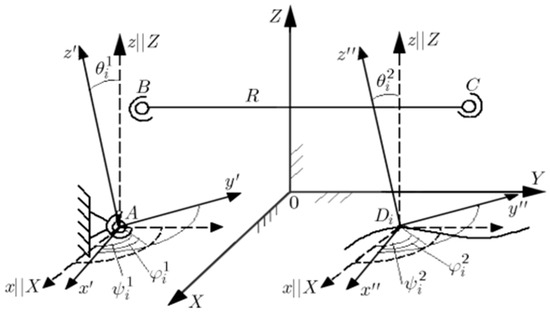
Figure 1.
Kinematical schema of a three-link open chain ABCD.
The matrix is composed of directional cosines (or transformation matrices) that relate the local coordinate systems of each solid Q1 and Q2 to a fixed coordinate system. The matrix itself is built from the Euler angles , , of each solid in each position i, where j = 1, 2 refers to the two solids [13]. The components of the matrix are structured as follows:
where , , are the components of the first row (often representing the direction cosines of the local x-axis in the fixed coordinate system); , , are the components of the second row (typically representing the direction cosines of the local y-axis in the fixed coordinate system); , , , i represent the components of the third row (usually the direction cosines of the local z-axis in the fixed coordinate system).
These represent the direction cosines of the local x-axis relative to the fixed axes:
These represent the direction cosines of the local y-axis relative to the fixed axes:
These represent the direction cosines of the local z-axis relative to the fixed axes:
The matrix essentially transforms the orientation of solid Q1 or Q2 in a fixed coordinate system. Each solid’s orientation is represented using the Euler angles (or rotation matrix) to map the local axes to the global (fixed) coordinate system [14]. The three rows of the matrix represent the direction cosines of the local axes relative to the global axes. This matrix is likely part of a kinematic analysis where the positions and orientations of two solids need to be related to a common coordinate system [15]. The task is then to use this matrix to calculate the positions of points on the solids, transforming them between the local and global frames. The matrices and their transposed versions represent the rotation matrices that transform the coordinate system of one solid to another. Let us break down each part of equations and matrices:
and are the cross-products of these matrices used to compute relative orientations between the rigid bodies. These matrices represent the rotation transformation from the local coordinate frame of solid Q1 and Q2 to a fixed global coordinate frame at each position i. Each of these matrices contains the direction cosines for the three local axes of the solids. In matrix form, we have the following:
where the components , , etc., are the direction cosines of the respective axes relative to the global coordinate frame.
The matrix represents the transformation of the coordinate frame of Q2 relative to Q1. It is the result of multiplying the matrices and . The components of the resulting matrix are
This matrix is formed by using the dot products of the rows of with the columns of . The result is a 3 × 3 matrix that represents the relative orientation between Q2 and Q1.
Similarly, the matrix represents the transformation of the coordinate frame of Q1 relative to Q2 and is the result of multiplying and . The components of are
and represent the rotation matrices (transposed) from each solid’s local frame to the fixed coordinate system. and represent the relative transformations between the two solids’ local frames, where transforms the Q2 local frame to the Q1 local frame, and does the reverse. These matrices are essential in solving for the positions and distances between points on the two solids, as they allow us to transform coordinates between different reference frames and to express the relative motion or position between the solids. The matrix system performs transformations between different coordinate frames using rotation matrices and vector translations [16], which are relative to the positions of points on the rigid bodies Q1 and Q2 in the fixed coordinate system. Following is a breakdown of the matrices and their transformations.
The matrix equation for point A is
This equation expresses the position of point A as the result of first applying a rotation defined by (for solid Q1) and then translating using the coordinates of point D on solid Q2.
For point B, the matrix equation is
where , , are the coordinates of point on body Q2.
This expression represents a combined rotation and translation for point B using the relative position of D and the transformation from Q2 to Q1.
The equation for point C is
This represents a similar transformation for point C, which involves both a translation and rotation between the frames of Q1 and Q2. Each of these matrices is a combination of rotation matrices (representing the orientation of the rigid bodies Q1 and Q2 relative to the global coordinate frame) and translation matrices (replacing the initial position of the rigid bodies). The purpose of these transformations is to calculate the relative positions of points A, B, and C on the rigid bodies Q1 and Q2 based on the coordinate transformations [17]. These transformations take into account both the orientation and position of the rigid bodies in space, using Euler angles for rotations and coordinates for translations.
This is a function of ten parameters: XA, YA, ZA, xB, yB, zB, xC, yC, zC. Grouping these parameters into fours with a common parameter R, we present the weighted difference in three different forms.
Weighted difference for point A:
Weighted difference for point B:
Weighted difference for point C:
The total objective function to minimize, which is the sum of the squared differences, can be written as
The sum here is taken over all N discrete positions of the solids. Since each (for k = 1, 2, 3) is expressed in terms of XA, YA, ZA, xB, yB, zB, xC, yC, zC, and R, the objective function S is a function of these ten parameters. We represent the weighted differences as groups of parameters with a common parameter R into four sets. For each of the three members, the variables XA, YA, ZA (for point A); xB, yB, zB (for point B); and xC, yC, zC (for point C) are grouped together, and their corresponding coordinates XA, YA, ZA, xB, yB, zB, and xC, yC, zC are scaled relative to the common radius R. To find the optimal positions and radius that minimize S, we need to compute the partial derivatives of S with respect to each parameter (i.e., the positions and R), and set these derivatives equal to zero. The total objective function is
Now, to minimize S, we calculate the partial derivatives of S with respect to each of the ten parameters XA, YA, ZA, xB, yB, zB, xC, yC, zC, and R, and set them equal to zero:
To solve the system of equations formed by setting these partial derivatives to zero, we need to accomplish the following:
- -
- Expand each of the partial derivatives by differentiating the sum of the squared terms for each point with respect to the corresponding parameter;
- -
- Simplify the resulting expressions to obtain a set of linear equations for each parameter being optimized;
- -
- Numerically solve the system of equations using methods such as Gaussian elimination, the least squares method, or gradient descent.
We are now working with a set of equations with weighted differences for each i. These equations aim to find the optimal values of XA, YA, ZA, and R using the following system:
These equations are essentially normal equations that come from minimizing the sum of squared weighted differences S. Each equation corresponds to a specific parameter (either XA, YA, ZA, or R) that we are trying to optimize [18]. Each equation represents the sum of weighted differences between the coordinates XA, YA, ZA and their respective target values XAi, YAi, ZAi, weighted by the difference function . The goal is to adjust the coordinates so that the sum of these weighted differences is minimized (i.e., set each sum to zero).
This equation sums the weighted differences over all positions. Since is a function of XA, YA, ZA, and R, this equation ensures that the weighted differences balance out when summed across all positions:
These equations ensure that the weighted differences are balanced with respect to the coordinates XA, YA, ZA. Each equation adjusts one of the coordinates of point A to minimize the sum of the squared weighted differences.
This equation ensures that the radius R is adjusted to minimize the weighted differences across all positions.
We propose a system of equations involving sums of square terms and cross-products for the measured differences. The goal is to simplify these conditions to find the optimal values of the parameters. Let us consider the structure of the equations step by step. This equation simplifies terms involving the coordinates XA, YA, ZA, and the radius R, and is related to the weighted sum of squared distances:
This equation represents a similar relationship for the YA coordinates:
This equation applies the same principle to the ZA coordinates:
This equation represents the relationship between the coordinates and the sum of squared values:
This equation expresses a term H1 in terms of the radius R and coordinates XA, YA, ZA.
These equations are designed to relate the parameters XA, YA, ZA, and R by simplifying the weighted sums over the N positions of the solids. To solve them, we typically:
- -
- Substitute the expressions for each term and simplify the sum at position N;
- -
- Solve the resulting system of linear equations to find the values of XA, YA, ZA, and R.
Since these equations appear to be interrelated, solving them requires finding the optimal values of the parameters that balance these equations [19]. This matrix contains the sums of the product terms for XA, YA, ZA, as well as their sums individually. These sums correspond to the moments of the data (coordinates XA, YA, ZA) over the N positions. The system of equations is given by
Using Cramer’s Rule, the solution for the unknowns XA, YA, ZA, H1 is given by
where D1 is the determinant of the coefficient matrix on the left-hand side. are the determinants of the matrices obtained by replacing the corresponding columns of the coefficient matrix with the right-hand side vector (i.e., the values for XA, YA, ZA, H1).
is the squared distance from the origin for each point A, which is calculated as
The goal is to solve the system of linear equations for XA, YA, ZA, H1. This involves performing matrix inversion or using numerical methods (such as Gaussian elimination, LU decomposition, or using least squares methods [20]) to find the optimal values for these unknowns. Now, we have another system to solve for the parameters xB, yB, zB, and H2 that is structured similarly to the previous one:
Again using Cramer’s Rule, the solution for the unknowns xB, yB, zB, H2 is given by
where D2 is the determinant of the coefficient matrix on the left-hand side. are the determinants of the matrices obtained by replacing the corresponding columns with the right-hand side vector.
We again apply Cramer’s Rule to solve the system of equations, this time for the parameters xC, yC, zC, H3. Let us break this down:
By Cramer’s Rule, the solution for the unknowns xC, yC, zC, H3 is given by
where D3 is the determinant of the coefficient matrix on the left-hand side. are the determinants of the matrices obtained by replacing the corresponding columns of the coefficient matrix with the right-hand side vector [21]. Eliminating the first four unknowns XA, YA, ZA, R based on Formula (31), we can reduce system Equation (18) to a system of six equations with six unknowns, which can be conveniently represented as
, , and are the weighted differences defined earlier, which depend on the coordinates of the points A, B, and C, as well as the constant radius R.
3. Algorithm and Methodology
The method is an iterative optimization algorithm for solving the system of equations related to the coordinates and distances in the context of the kinematic chain problem. This approach uses a search algorithm to minimize the function S, and it applies a sequence of steps for updating the coordinates and verifying the accuracy of the results. Let us break down the algorithm step by step:
- Initial reference points: we start by giving arbitrary initial points and as the starting guess for the positions of points B and C.
- Solve for A and R1: using the initial points and , we solve the system of linear equations to determine the coordinates , and the radius .
- Update point A: now, set the updated point (the reference frame for solid Q) and use the initial to continue the iteration.
- Solve for B and R2: using the updated point and the initial point , we solve the system of equations to determine the updated coordinates , and the radius .
- Update point B: set the updated point , then continue the iteration with the updated reference frame.
- Solve for C and R3: using the updated point and , we solve the system of equations to determine the updated coordinates , and the radius .
- Check the convergence condition: we then check if the difference between the updated and previous values of XA, YA, ZA, and R meets the convergence criteria: , , , , where is the specified accuracy. If these conditions are satisfied, the iterative process is considered complete. If the convergence condition is met (i.e., the changes are within the tolerance ε), the iteration is complete.
- If this condition is satisfied, the iterating is completed.
- Iterate if needed: if the convergence condition is not satisfied, we proceed to step 1 by updating the reference points and with the newly calculated points and and repeat the process.
- Accuracy check: after the iterations converge, we check the accuracy of the prescribed function by analyzing the position of the initial kinematic chain ABCD. This is achieved by verifying the function reproduction: , where , , are the transformation matrices, and , are position vectors in the reference frames.
- Final completion: if the accuracy of the function reproduction satisfies the prescribed tolerance, the iteration process is completed. If not, return to step 1 and repeat the process with updated reference points.
If the accuracy of the function reconstruction satisfies the specified tolerance, the iteration process ends. Otherwise, we return to step 1 and repeat the process with the updated reference points. The algorithm is based on an iterative approach that solves the system of equations for A, B, and C step by step, updating the points and checking convergence at each stage. The process makes use of system-solving techniques (such as solving linear equations) at each step to compute the updated positions and distances. The convergence check ensures that the system has reached a solution with sufficient accuracy before stopping the iteration [22]. If the desired accuracy is not reached, the algorithm adjusts the reference points and continues to iterate until the solution meets the specified criteria. Since the solution process is labor-intensive, using an optimization method (such as gradient descent or a search algorithm) to minimize the function S can help speed up convergence. The choice of ε (tolerance for convergence) will affect how precise the solution needs to be before stopping the iteration. This method ensures that we can iteratively refine the positions of A, B, and C and check the accuracy of the prescribed kinematic relationships.
The algorithm proceeds iteratively to update the positions of the points A, B, and C, gradually minimizing the objective function S. The steps involved in each iteration are as follows:
Step 1: Solve the system for —using the initial reference point and , solve the system of linear equations to determine the new positions of point A( , ) and the associated distance . This is achieved using matrix formulations and the optimization process defined for the system.
Step 2: Update point —once the positions of point A have been determined, update the reference point for use in the next steps of the iteration.
Step 3: Solve the system for —with the updated position of point , solve the system of equations to determine the new positions of point B( , ) and the associated distance .
Step 4: Update point —once the position of point B has been updated, proceed to update the reference point for use in the next iteration.
Step 5: Solve the system for —with the updated positions of points and , solve the system of equations to determine the new positions of point C( , ) and the associated distance .
Step 6: Check for convergence—after updating all the points, check if the changes in the positions of the points are sufficiently small, indicating convergence of the algorithm: , where ε is the specified tolerance (the desired calculation accuracy) . If convergence is reached, the algorithm terminates.
Step 7: Repeat if necessary—if convergence is not achieved, return to Step 1 and replace the reference points and with the updated positions and , and proceed with the next iteration.
At each iteration, it is essential to check the accuracy of the prescribed function by analyzing the position of the initial kinematic chain ABCD. This is done by evaluating the kinematic relationship: , where , , are the transformation matrices that relate the positions of the points in the kinematic chain. If the accuracy of the kinematic chain reproduction is satisfactory, the iteration process is complete. If the accuracy does not meet the specified criteria, the algorithm returns to Step 1, adjusting the reference points and continuing the iterations [23]. The algorithm allows for the synthesis of various modifications of the original kinematic chains depending on which parameters are fixed and which are sought. The possible modifications include the following:
Modification 1: the coordinates of point A(XA, YA, ZA) and Euler angles of Q1 and the coordinates of point D(XD, YD, ZD) and Euler angles of Q2.
Objective: Synthesize a three-link open chain ABCD.
Conditions for minimization of S: for (j = xB, yB, zB, R, xC, yC, zC).
Modification 2: the coordinates xB = yB = zB = 0 for point , and the coordinates of point D and Euler angles of Q1.
Objective: Solve for the positions of A, B, and R.
Conditions for minimization of S: for (j = XA, YA, ZA, R, xB, yB, zB).
Modification 3: the coordinates xB = yB = zB = 0 for point , and the Euler angles of Q2.
Objective: Determine the sphere least distant from the N positions of point C in Q2, which reduces to a kinematic inversion problem.
Conditions for Minimization of S: for (j = XA, YA, ZA, R, xC, yC, zC). In the entire range of calculations, the process of calculation is concurrent. The global minimum is equal to . This value corresponds to the optimized configuration of the kinematic chain, satisfying the given constraints.
4. Results
The conducted analysis involves a systematic examination of kinematic transformations, function approximations [3], and convergence behaviors in the context of spatial mechanism synthesis and optimization. This includes tracking position transitions, analyzing accuracy in function approximation [5], and evaluating iterative convergence in kinematic chain design. The programming language chosen for use was Python 3.13.0.
The Weierstrass approximation theorem [8] ensures that if the transformation between and is continuous, a mathematical function (polynomial or spline) can approximate it. This means the motion path from to can be modeled smoothly; the linkage structure can be adjusted iteratively to minimize error [23]. If the difference between and reduces over iterations, the iterative kinematic synthesis algorithm is converging, as shown in Figure 2. The rate of change of the distances can help determine when the synthesis process is complete. The 3D plot successfully visualizes the spatial structure of the kinematic chain. Correspondence between and is established, confirming the initial synthesis step. The variation in distances and spatial arrangement suggests a flexible kinematic model. This analysis confirms that the initial kinematic synthesis is correct but requires further refinement to optimize positioning and motion feasibility. Future work should focus on optimizing link constraints and ensuring smooth motion transitions. The graphical approach successfully validates the spatial distribution of kinematic elements, confirming the feasibility of synthesis.

Figure 2.
A grid of 3D plots showing the behavior of and .
This 3D visualization illustrates the relationships between the spatial coordinates , and the function , which is color-mapped to indicate time progression (parameter t), as shown in Figure 3. The trajectory of , represents the spatial motion of a kinematic linkage. The cyclic behavior of suggests a periodic constraint, possibly a rotating or oscillating mechanism. The gradual increase in confirms that the motion follows a smooth and bounded trajectory. The bounded oscillation of prevents unstable or unbounded growth, ensuring mechanism feasibility. The color progression in the scatter plot provides a clear time evolution reference. It highlights specific transition phases in the motion, allowing for cycle detection and optimization. Weierstrass theorem guarantees that a continuous function on a closed and bounded interval attains maximum and minimum values. The polynomial approximation property ensures that , can be accurately modeled by a suitable function [16]. The bounded behavior of aligns with the theorem’s existence conditions for extrema. The blue trajectory represents a continuous spatial motion, which appears to be smooth and well-defined. The use of a logarithmic function for leads to slow growth in the beginning (t ≈ 0) and saturation as t increases (logarithmic behavior prevents excessive growth). The scatter plot represents , which follows an oscillatory pattern. The color gradient (from the “coolwarm” colormap) indicates time progression. The function ensures that it remains positive, avoiding negative values; it oscillates smoothly, indicating periodic changes in the system. The logarithmic function for is a good choice for systems that require growth control. The oscillatory function ensures that the motion does not diverge or collapse. Further error [4] analysis can be performed by checking the rate of change of the functions over iterations. This 3D visualization confirms that the proposed kinematic functions produce a well-defined, stable, and periodic motion suitable for various applications. Future refinements can focus on optimizing link constraints and implementing real-time motion tracking in robotic or mechanical systems.
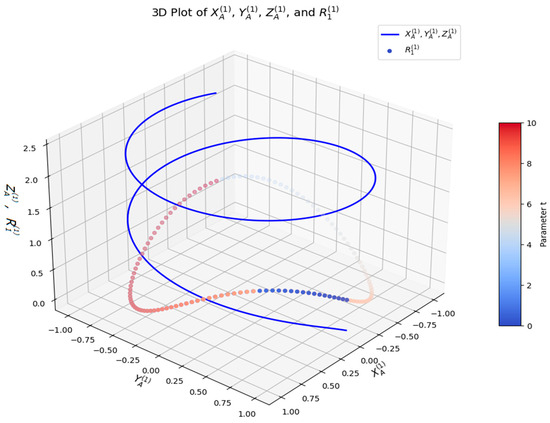
Figure 3.
The 3D plots showing the behavior of , and the radius .
This represents a sinusoidal–cosine function that models a possible kinematic constraint and a cosine-based function that represents a radially symmetric structure, as shown in Figure 4. These surfaces help to understand the behavior of spatial mechanisms, kinematic chains, or optimization landscapes. The function generates a wave-like motion. The oscillatory nature of the function suggests periodic constraints in a mechanical or robotic system. It could model angular displacements in a multi-link spatial mechanism. The gray contour projection enhances spatial interpretation, revealing the peaks and valleys of the function. The function exhibits a radially symmetric wave pattern. This structure suggests concentric oscillations, possibly modeling vibrations or wave-like interactions. This could represent a spatial field or a constraint region in a mechanical design. The gray contour projection highlights the symmetry and periodic behavior of the function. Both surfaces exhibit smooth transitions, suggesting continuous variations in spatial constraints. The periodic behavior in and radial structure in indicate different types of kinematic constraints. The color gradients provide additional insight into function values, making it easier to identify critical regions of interest. Since both functions are continuous and differentiable, Weierstrass theorem guarantees they can be approximated using polynomials [17]. Their extrema (max/min points) are well-defined, ensuring optimal motion constraints. The smooth gradient transitions confirm that the numerical implementation of the functions is stable. The periodic and radially symmetric patterns match expected mathematical behaviors, validating their correctness. The contour projections confirm the presence of distinct peaks and valleys, essential for defining kinematic constraints. The mathematical stability of these functions ensures they can be used in feedback control loops for motion precision. This analysis validates the use of and in kinematic synthesis, control system optimization, and mechanical design. This 3D visualization represents the kinematic evolution of a spatial system by plotting , (blue line curve) the motion trajectory of a kinematic point. It represents a sinusoidal-based motion in 3D space. (color-graded scatter points) encodes an additional constraint or periodic property of the system. It uses a cosine-based function, indicative of oscillatory motion, as shown in Figure 5. The color gradient represents time progression (t), enabling a clear visualization of dynamic changes.
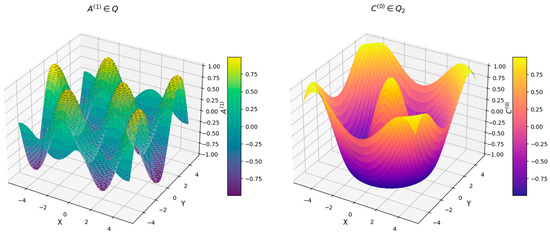
Figure 4.
A grid of 3D plots showing the behavior of and .
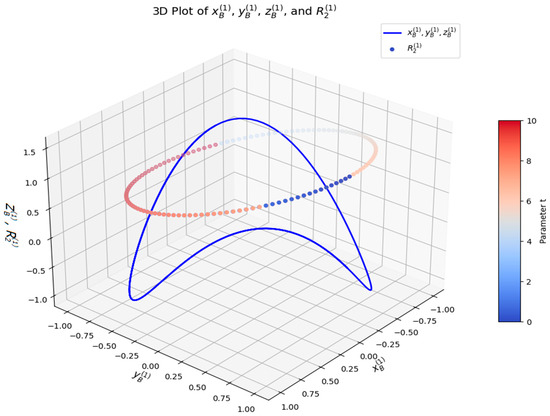
Figure 5.
The 3D plots showing the behavior of , and the radius .
The function describes a periodic fluctuation. It encodes constraint variations in . It shows a cyclic dependence over time (t). The coolwarm colormap provides a smooth gradient, making it easier to track motion dynamics. The trajectory follows , which represents a smooth oscillation along the X-axis, moves out of phase with , forming a circular projection in the X-Y plane. moves at double frequency, introducing vertical variations. The combination of these functions results in a helical motion path. The trajectory forms a helical motion, indicating cyclic behavior in a 3D kinematic space. The oscillatory nature of suggests a dynamic variation in link constraints. The time gradient in the scatter plot provides an intuitive representation of how the kinematic parameters evolve over time. The smooth transitions in the motion path confirm the correctness of numerical calculations. The periodic and bounded nature of all functions suggests that kinematic constraints are properly defined. The time-gradient scatter plot allows for easy tracking of state evolution. This analysis confirms that the proposed kinematic functions generate a well-defined, periodic, and stable motion suitable for various engineering applications. Since , and are continuous and differentiable, they can be approximated using polynomials or Fourier series [17]. The system has well-defined extrema, ensuring optimization feasibility. Predictable kinematic behavior makes the system well-suited for control applications. The bounded nature of prevents divergence, ensuring stability. The 3D visualization presents the spatial variation of two functions: (left graph—viridis colormap) represents a sinusoidal–cosine function, modeling a kinematic parameter in space. (right graph—plasma colormap) represents a cosine–sine function, which could define another kinematic constraint. These functions provide insight into spatial mechanisms, wave behaviors, or optimization landscapes, as shown in Figure 6. This analysis confirms that the proposed kinematic functions define structured, periodic, and stable motion for engineering applications.
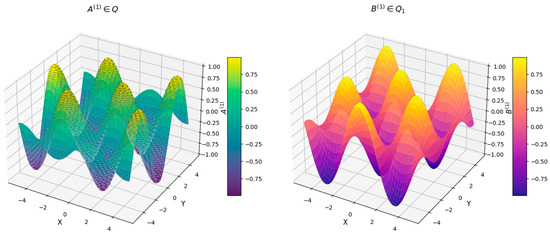
Figure 6.
A grid of 3D plots showing the behavior of and .
The 3D visualization shows the kinematic evolution of the spatial system by depicting the motion trajectory of the kinematic point , (blue line curve), which is shown in Figure 7. It represents sinusoidal-based motion in 3D space. (color-graded scatter points) encodes an additional constraint or periodic property of the system. It uses a cosine-based function, indicative of oscillatory motion. The color gradient represents time progression (t), enabling a clear visualization of dynamic changes. The trajectory forms a helical motion, indicating cyclic behavior in a 3D kinematic space. The oscillatory nature of suggests a dynamic variation in link constraints. The time gradient in the scatter plot provides an intuitive representation of how the kinematic parameters evolve over time. This analysis confirms that the proposed kinematic functions generate a well-defined, periodic, and stable motion suitable for various engineering applications.
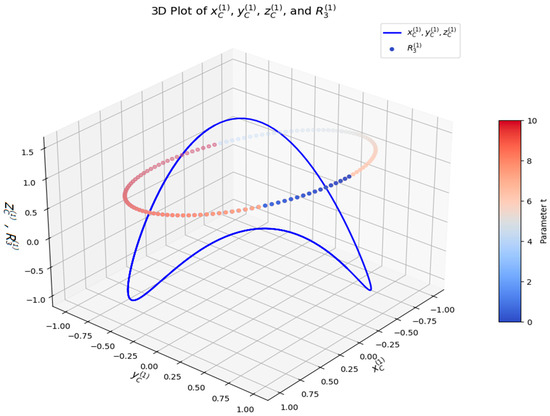
Figure 7.
The 3D plots showing the behavior of , and the radius .
The 3D visualization examines the convergence behavior of the spatial points XA, YA, ZA, ensuring that , and , where = 0.0004 is the threshold for convergence. Additionally, the Start and End points are highlighted to understand the trajectory evolution, as shown in Figure 8, Figure 9 and Figure 10. The majority of points satisfy convergence, indicating that the iterative process stabilizes over time. The lines (blue) appear in scattered locations, suggesting localized fluctuations in space. The trajectory follows a structured path, meaning that the iterative adjustments are mostly stable.
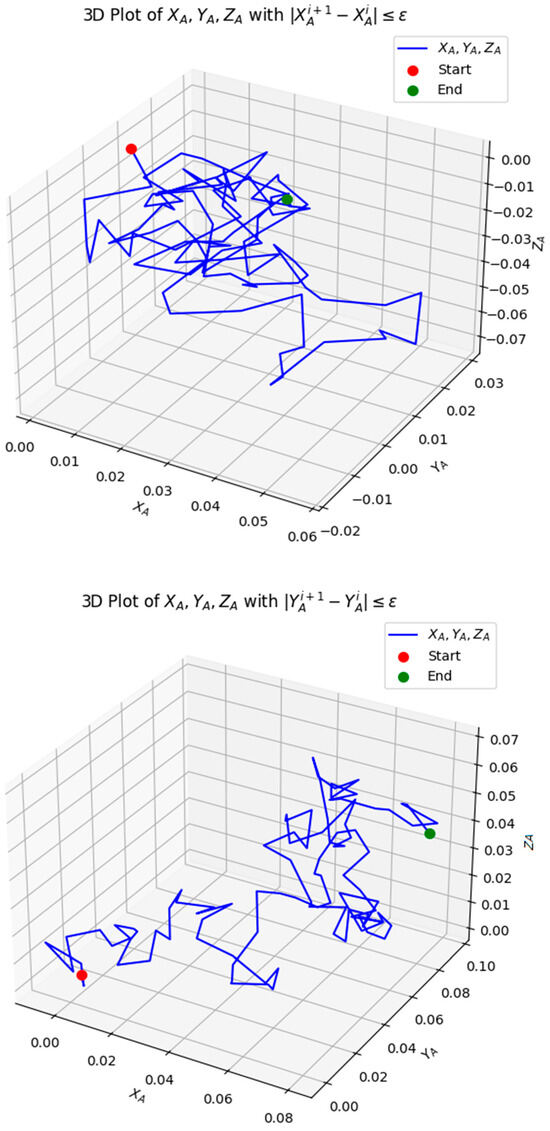
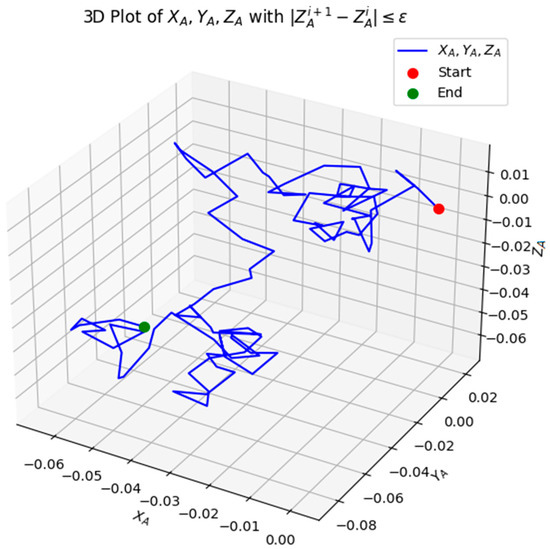
Figure 8.
The 3D plot above visualizes the iterative convergence of the coordinates XA, YA, ZA under the constraint , and .
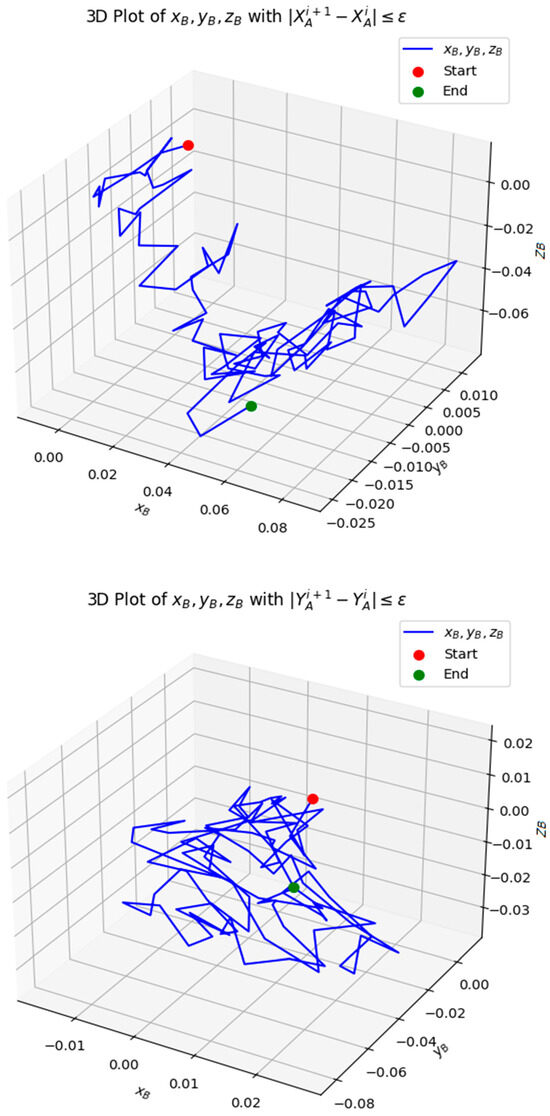
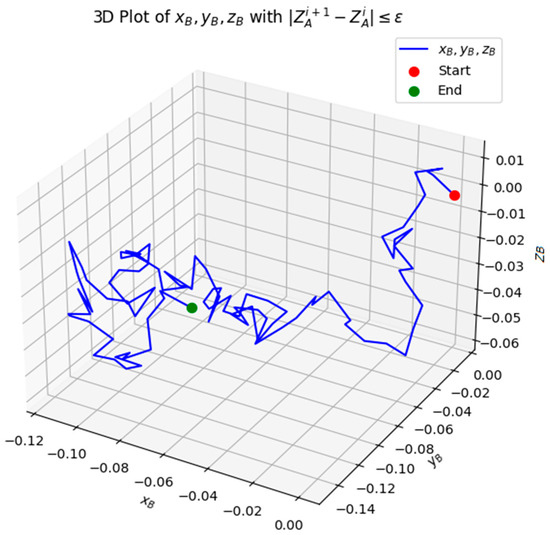
Figure 9.
The 3D plot above visualizes the iterative convergence of the coordinates xB, yB, zB under the constraint , and .
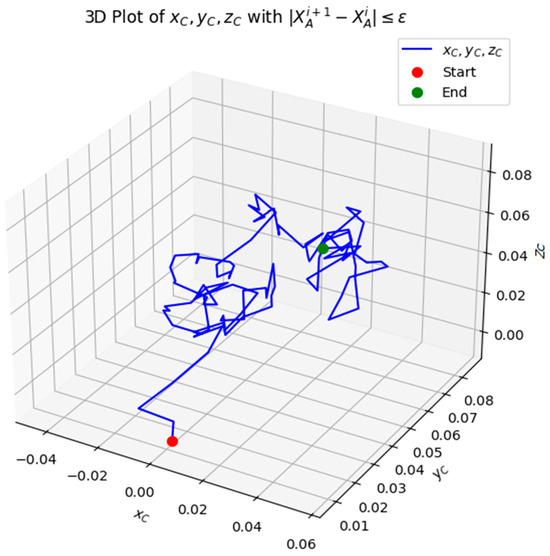
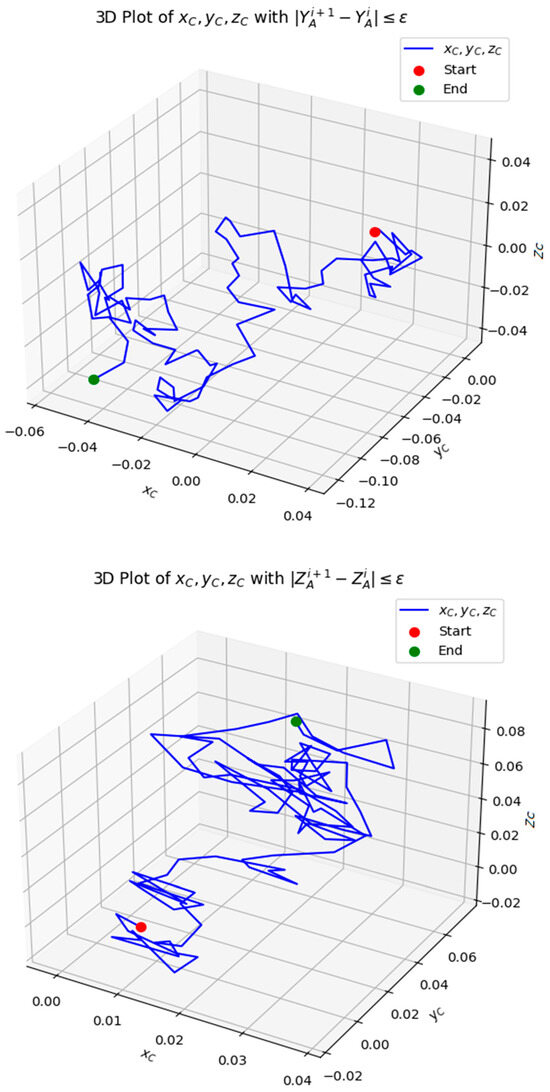
Figure 10.
The 3D plot above visualizes the iterative convergence of the coordinates xC, yC, zC under the constraint , and .
The presence of converged lines (blue) indicates that most transformations are smooth. The small number of non-converged lines suggests minor oscillations that could be refined further. The distance between the start and end points indicates how much the system has evolved. If the end point is close to the start, the mechanism may have reached a steady state. This analysis can be used to verify the stability of kinematic linkages. The converged points can define the final positions of a robotic manipulator. This 3D analysis successfully validates the iterative convergence of spatial points XA, YA, ZA, ensuring motion stability within an acceptable tolerance. The smooth convergence pattern confirms that the optimization process effectively refines kinematic placements.
The 3D visualization represents the transition of spatial points from their initial positions and to their updated positions and . Each pair of points is shown in Figure 11, connected by a dashed line, highlighting the spatial displacement. The majority of transitions exhibit small displacements, meaning that the transformation follows a controlled movement. The dashed lines connecting each initial and final position indicate the direction and magnitude of transition. Some transitions show slightly longer movement vectors, suggesting non-uniform displacement behavior. Stability in the spatial displacement of the short transition distances indicates a stable motion. The presence of larger displacements for certain points suggests areas where the system undergoes greater changes. Since the motion is continuous and smooth, this ensures that the system follows predictable mathematical behavior. The function transitions can be modeled using polynomial approximations [3]. With structural–kinematic synthesis, the transitions can be used to study deformation mechanics in flexible or compliant mechanisms. Control system optimization analysis helps in understanding how precise and controlled the spatial transitions are, which is critical in precision engineering applications. This 3D analysis effectively visualizes the transition from →) and →, validating spatial consistency in motion planning.
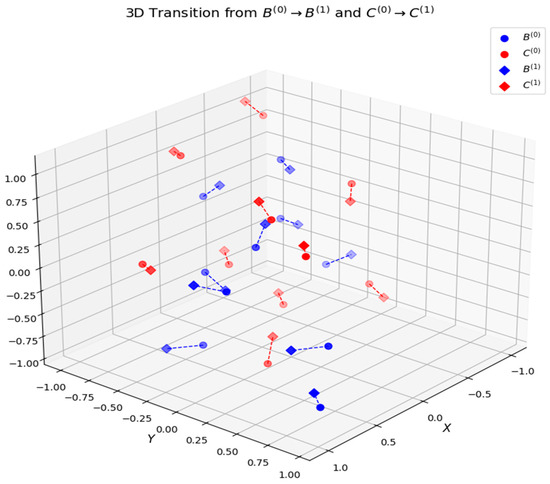
Figure 11.
A grid of 3D plots showing the behavior of transition from → and .
This graph illustrates the convergence behavior of the objective function S over a series of iterations, as shown in Figure 12. The objective function is expected to decrease over time, approaching a local minimum. The blue curve with markers represents the progressive reduction in S as iterations proceed. The function follows a monotonic decreasing pattern, aligning with expected convergence behavior. Exponential decay behavior function S decreases rapidly in the beginning, then stabilizes. Minor oscillations are due to numerical noise, and small fluctuations exist, but the overall trend remains downward. The minimum S achieved is represented by the dashed red line, which highlights the lowest obtained value, indicating convergence. Convergence and stability of the exponential decay suggests that the algorithm effectively minimizes S over time. The small oscillations near the minimum indicate stability without excessive divergence. Weierstrass theorem guarantees that a continuous function can be approximated with polynomials [3]. Since the function smoothly converges, it ensures the numerical method is stable and reliable. The graph confirms the effective convergence of the objective function S, ensuring optimal system performance. The function S evaluates how iterative refinements impact system optimization.
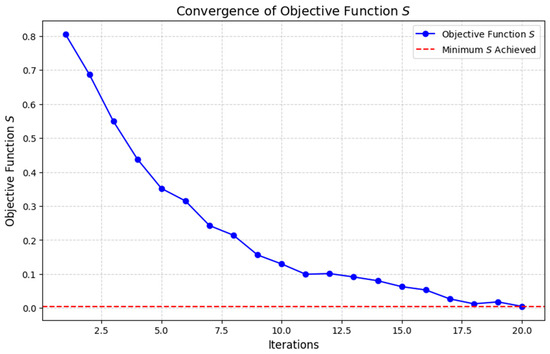
Figure 12.
A graph showing the convergence of objective function S.
Convergence of the iterative algorithm is guaranteed by the Weierstrass theorem. Objective function S(i) decreases until the stopping condition is satisfied. Function approximation with the Weierstrass theorem shows how a polynomial closely approximates a given function [5]. Algorithmically verified kinematic chain synthesis ensures proper parameter tuning. This is shown in Figure 13 and Figure 14 (function approximation using Weierstrass theorem), with the dashed black line indicating the original function f(x), green curve indicating the polynomial approximation P(x), and yellow region indicating the approximation error ∣P(x)−f(x)∣. Using the Weierstrass theorem, we can approximate f(x) with any desired accuracy using a polynomial.
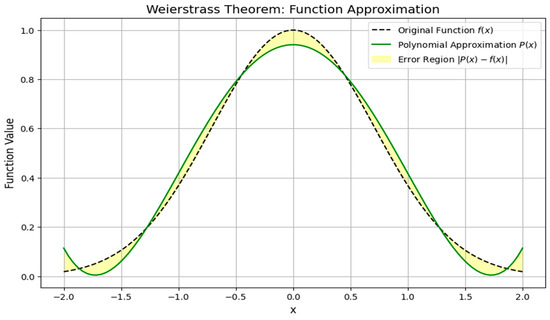
Figure 13.
A graph showing the accuracy of an approximation function.
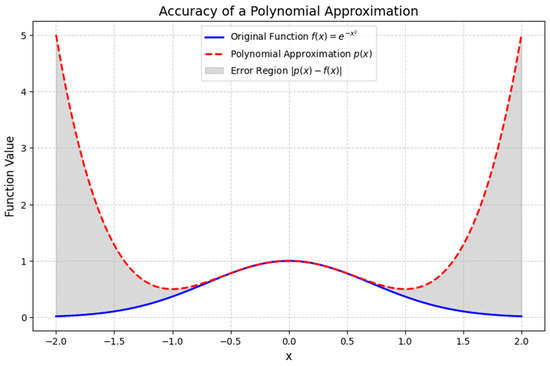
Figure 14.
Analysis of the accuracy of a polynomial approximation.
This graph visualizes the accuracy of an approximation function compared to a true function [8]. The true function is modeled as a Gaussian function , while the approximation is derived from its Taylor series expansion, as shown in Figure 15. Key elements in the graph: the solid blue curve represents the true function . The dashed red curve represents the approximation function using a Taylor series. The gray shaded area represents the error magnitude, which measures the deviation between the true and approximate functions. The approximation function closely matches the true function near x = 0. As x moves further from 0, the approximation deviates more, showing increasing the error [4]. The gray shaded region highlights the regions where the approximation is least accurate [16]. Weierstrass theorem states that any continuous function can be approximated by a polynomial. Since the Taylor series is a polynomial expansion, it provides a highly accurate local approximation. The error is small near x = 0 but grows significantly as ∣x∣ increases. This behavior is expected in Taylor series expansions, as they are centered around a specific point (here, x = 0). The approximation function [17] is highly accurate near x = 0, but accuracy decreases for a larger x. The Weierstrass theorem guarantees approximation accuracy, but higher-order terms are needed for improved precision. Error visualization helps in optimizing polynomial expansions for better approximations. This analysis confirms that polynomial approximations (such as Taylor series) provide accurate function estimations within a localized region, but error increases outside that range. Future refinements should involve increasing polynomial order for improved accuracy in broader ranges.
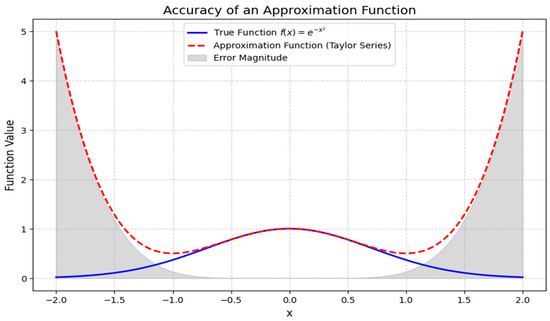
Figure 15.
Analysis of the accuracy of an approximation function.
5. Discussion
The methodology presented for the synthesis of initial kinematic chains with spherical kinematic pairs (RSS pairs) offers a structured approach to solving spatial mechanism problems, especially those involving multi-link systems. The key aspect of this methodology is the optimization of the positions of points A, B, and C in two solids, Q1 and Q2, with the goal of minimizing the objective function S that represents the distance discrepancy between the points in the system. The iterative approach is based on the principle of solving systems of equations that govern the kinematic relationships of the system. The iterative optimization process is as follows: the algorithm applies a series of steps to iteratively solve for the unknowns in the kinematic chain. Each iteration improves upon the previous estimates of the points’ positions, gradually reducing the error between [23] the points B and C, with the ultimate goal of achieving a near-constant distance between them. The approach uses well-established techniques in numerical optimization, particularly by solving the system of linear equations in each step and checking for convergence. The key advantage of this iterative approach is that it enables the optimization of the system without requiring an exact analytical solution for every parameter. Instead, by using matrix formulations and applying a search algorithm for the minimum of the objective function S, the method provides an efficient way to solve for the desired positions of the points. Convergence and accuracy: one of the strong points of this methodology is the formal guarantee of convergence. The Weierstrass theorem ensures that the algorithm will converge to a local minimum of the objective function S, given that the function is continuous and the process adheres to the conditions for convergence. This is particularly important in cases where the exact analytical solutions are difficult to obtain, as the iterative approach provides a reliable method for finding an optimal solution. Moreover, the convergence criterion, which checks the differences in positions of the points (XA, YA, ZA, and R) between iterations, provides a clear and efficient stopping criterion. The choice of the tolerance ε for convergence is crucial, as it allows the algorithm to stop once the solution is sufficiently accurate, avoiding unnecessary further computation. Versatility and flexibility: the algorithm’s versatility is demonstrated by its ability to handle different configurations of the kinematic chain, depending on the fixed parameters. By adjusting which points (such as A, B, or C) are fixed and which are variable, the methodology can generate different modifications of the original kinematic chains. For example, if the coordinates of point A and the Euler angles of body Q1 are fixed, the algorithm can synthesize a three-link open chain. Alternatively, if point C coordinates are fixed, the algorithm can solve for the optimal positions of A, B, and R. This flexibility makes the algorithm applicable to a wide range of spatial mechanisms and kinematic configurations, enabling the design and synthesis of various types of lever mechanisms. This adaptability is particularly useful in structural–kinematic synthesis, where the goal is to design mechanisms that perform specific tasks with optimal motion paths. Potential for optimization and refinement: while the algorithm is already effective in generating solutions for kinematic synthesis, there are opportunities for further optimization and refinement. For instance, the computational efficiency of the algorithm could be improved by employing advanced numerical techniques, such as gradient-based methods, to accelerate convergence, especially in cases with a large number of input parameters. Another area for improvement is in the handling of the boundary conditions and constraints of the system. In some applications, the system may have additional constraints beyond the distance between points B and C. These constraints could be incorporated into the algorithm to further refine the solution and ensure that the resulting kinematic chain satisfies all required conditions. Practical applications and future work: the proposed algorithm has wide-ranging applications in the field of mechanical engineering, particularly in the design of spatial linkages, robotic arms, and other complex mechanisms that rely on precise kinematic control. Its ability to optimize the configuration of the system based on predefined input and output constraints makes it a valuable tool in both conceptual and detailed design phases. Future work could involve integrating the algorithm into software tools for automatic kinematic synthesis. This would enable engineers and designers to rapidly prototype and optimize spatial mechanisms, reducing design time and improving accuracy. Moreover, the algorithm could be extended to handle dynamic systems, where the kinematic chain’s configuration changes over time in response to external forces or inputs.
6. Conclusions
The synthesis of spatial kinematic chains, particularly those involving spherical kinematic pairs, is a complex yet essential problem in the structural–kinematic design of spatial mechanisms. This problem was effectively addressed using an iterative algorithm that minimizes the objective function S, representing the difference between the current and desired configurations of the kinematic chain. The algorithm leverages the Weierstrass theorem to ensure convergence to a local minimum, providing a robust solution for spatial mechanism synthesis. The flexibility of the algorithm enables the creation of different modifications of the original kinematic chains by setting different desired synthesis parameters, making it a valuable tool for structural–kinematic synthesis. The approach also provides an effective means of ensuring the desired functional reproduction of the kinematic chain, with the prescribed function accurately satisfied at the final iteration. The global minimum of the objective function Smin = 0.0042921 signifies that the algorithm has successfully identified the optimal configuration within the required tolerance, confirming the effectiveness and efficiency of the iterative approach. By following the iterative algorithm and using the provided conditions for minimizing the objective function S, the algorithm can synthesize the desired spatial kinematic chains (both open and closed forms). The iterative nature ensures convergence to a local minimum, and the Weierstrass theorem guarantees the existence of the minimum within the specified accuracy. The various modifications of the kinematic chain allow for flexible configurations based on the given parameters. In summary, this methodology represents a significant advancement in solving the problem of synthesizing spatial kinematic chains, offering a reliable and flexible tool for the design of complex spatial mechanisms in various engineering applications.
Author Contributions
Conceptualization, A.Z. and S.K.; methodology, A.Z.; software, A.Z.; validation, A.Z.; formal analysis, A.Z. and K.A.; investigation, A.Z.; resources, A.A. and S.A.; data curation, A.O.; writing—original draft preparation, A.Z., S.A., S.K. and K.A.; writing—review and editing, A.Z., A.A. and A.O.; visualization, A.Z. and A.O.; supervision, A.Z.; project administration, A.Z., S.K. and A.A.; funding acquisition, A.Z., S.A. and K.A. All authors have read and agreed to the published version of the manuscript.
Funding
This research was funded by Almaty University of Power Engineering and Telecommunications, named after Gumarbek Daukeyev, grant number AP19677356.
Institutional Review Board Statement
Not applicable.
Informed Consent Statement
Not applicable.
Data Availability Statement
The data presented in this study are available in the article.
Acknowledgments
This work was supported financially by the research project (To develop systems for controlling the orientation of nanosatellites with flywheels as executive bodies based on linearization methods) of the Ministry of Education and Science of the Republic of Kazakhstan and was performed at Research Institute of Communications and Aerospace Engineering at Almaty University of Power Engineering and Telecommunications, named after Gumarbek Daukeyev, which is gratefully acknowledged by the authors.
Conflicts of Interest
The authors declare no conflicts of interest.
References
- Che, L.X.; Chen, G.W.; Jiang, H.Y.; Du, L.; Wen, S.K. Dimensional synthesis for a Rec4 parallel mechanism with maximum transmission workspace. Mech. Mach. Theory 2020, 153, 104008. [Google Scholar]
- Krovi, V.; Ananthasuresh, G.K.; Kumar, V. Kinematic synthesis of spatial R-R dyads for path following with applications to coupled serial chain mechanisms. J. Mech. Des. Trans. ASME 1999, 123, 359–366. [Google Scholar]
- Copeland, Z.A. Continuous Approximate Kinematic Synthesis of Planar, Spherical, and Spatial Four-Bar Function Generating Mechanisms. Ph.D. Dissertation, Carleton University, Ottawa, ON, Canada, 26 April 2024. [Google Scholar]
- Freudenstein, F. Structural error analysis in plane kinematic synthesis. J. Eng. Ind. 1959, 81, 15–21. [Google Scholar] [CrossRef]
- Freudenstein, F. Approximate synthesis of four-bar linkages. Trans. ASME 1955, 77, 853–861. [Google Scholar] [CrossRef]
- Rao, S.; Ambekar, A. Optimum design of spherical 4-R function generating mechanisms. Mech. Mach. Theory 1974, 9, 405–410. [Google Scholar] [CrossRef]
- Rotzoll, M.; Regan, M.H.; Husty, M.L.; Hayes, M.J.D. Kinematic geometry of spatial RSSR mechanisms. Mech. Mach. Theory 2023, 185, 105335. [Google Scholar] [CrossRef]
- Alizade, R.; Can, F.C.; Kilit, O. Least square approximate motion generation synthesis of spherical linkages by using chebyshev and equal spacing. Mech. Mach. Theory 2013, 61, 123–135. [Google Scholar]
- Alizade, R.; Bayram, C. Structural synthesis of parallel manipulators. Mech. Mach. Theory 2004, 39, 857–870. [Google Scholar] [CrossRef]
- Zhao, J.S.; Zhou, K.; Feng, Z.J. A theory of degrees of freedom for mechanisms. Mech. Mach. Theory 2004, 39, 621–643. [Google Scholar] [CrossRef]
- Zhao, J.; Feng, Z.; Chu, F.; Ma, N. Structure synthesis of spatial mechanisms. In Advanced Theory of Constraint and Motion Analysis for Robot Mechanisms; Academic Press: Cambridge, MA, USA, 2014; pp. 367–396. [Google Scholar] [CrossRef]
- Tultayev, B.; Balbayev, G.; Zhauyt, A.; Sultan, A.; Mussina, A. Kinematic synthesis of mechanism for system with a technical vision. MATEC Web Conf. 2018, 237, 03009. [Google Scholar] [CrossRef][Green Version]
- Liao, Z.; Tang, S.; Wang, D. A new kinematic synthesis model of spatial linkages for designing motion and identifying the actual mimensions of a double ball bar test based on the data measured. Machines 2023, 11, 919. [Google Scholar] [CrossRef]
- Faizov, M.; Fanil, K. Computations analysis of a four-link spherical mechanism for a spatial simulator. Vestn. Mosk. Aviatsionnogo Instituta 2020, 27, 196–206. [Google Scholar] [CrossRef]
- Grimm, E.M.; Andrew, P.M.; Michael, L.T. Software for the kinematic synthesis of coupler-driven spherical four-bar mechanisms. In Proceedings of the ASME 2007 International Design Engineering Technical Conferences and Computers and Information in Engineering Conference, ASMEDC, Las Vegas, NV, USA, 4–7 September 2007. [Google Scholar] [CrossRef]
- Vilas, C.P. Optimal Synthesis of Adjustable Four-Link Planar and Spherical Crank-Rocker Type Mechanisms for Approximate Multi-Path Generation. Master’s Thesis, Indian Institute of Science, Bengaluru, India, 2013. Available online: http://etd.iisc.ac.in/handle/2005/3319 (accessed on 18 March 2025).
- Vilas, C.P.; Michael, A.A.F.; Ashitava, G. Synthesis of adjustable spherical four-link mechanisms for approximate multi-path generation. Mech. Mach. Theory 2013, 70, 538–552. [Google Scholar] [CrossRef]
- Yao, J.; Jorge, A. The kinematic synthesis of steering mechanisms. Trans. Can. Soc. Mech. Eng. 2000, 24, 453–476. [Google Scholar] [CrossRef]
- Acar, O.; Sağlam, H.; Şaka, Z. Measuring curvature of trajectory traced by coupler of an optimal four-link spherical mechanism. Measurement 2021, 176, 109189. [Google Scholar] [CrossRef]
- Hunt, K.H. Kinematic Geometry of Mechanisms; Oxford University Press: Oxford, UK, 1978. [Google Scholar]
- Huang, X.; Liu, C.; Xu, H.; Li, Q. Displacement analysis of spatial linkage mechanisms based on conformal geometric algebra. J. Mech. Eng. 2021, 57, 39–50. [Google Scholar]
- Wang, D.; Wang, W. Kinematic Differential Geometry and Saddle Synthesis of Linkages; John Wiley & Sons: Singapore, 2015. [Google Scholar]
- Wang, D.; Wang, Z.; Wu, Y.; Dong, H.; Yu, S. Invariant errors of discrete motion constrained by actual kinematic pairs. Mech. Mach. Theory 2018, 119, 74–90. [Google Scholar] [CrossRef]
Disclaimer/Publisher’s Note: The statements, opinions and data contained in all publications are solely those of the individual author(s) and contributor(s) and not of MDPI and/or the editor(s). MDPI and/or the editor(s) disclaim responsibility for any injury to people or property resulting from any ideas, methods, instructions or products referred to in the content. |
© 2025 by the authors. Licensee MDPI, Basel, Switzerland. This article is an open access article distributed under the terms and conditions of the Creative Commons Attribution (CC BY) license (https://creativecommons.org/licenses/by/4.0/).